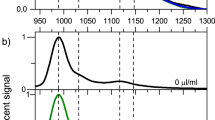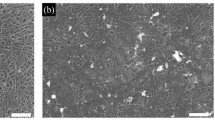Abstract
Single-walled carbon nanotubes provide an ideal system for studying the properties of one-dimensional (1D) materials, where strong electron–electron interactions are expected1. Optical measurements have recently reported the existence of excitons in semiconducting nanotubes, revealing the importance of many-body effects2,3,4. Surprisingly, pioneering electronic structure calculations5,6,7 and scanning tunnelling spectroscopy (STS) experiments8,9,10 report the same gap values as optical experiments. Here, an experimental STS study of the bandgap of single-walled semiconducting nanotubes, demonstrates a continuous transition from the gap reduced by the screening resulting from the metal substrate to the intrinsic gap dominated by many-body interactions. These results provide a deeper knowledge of many-body interactions in these 1D systems and a better understanding of their electronic properties, which is a prerequisite for any application of nanotubes in the ultimate device miniaturization for molecular electronics11,12, or spintronics13.
This is a preview of subscription content, access via your institution
Access options
Subscribe to this journal
Receive 12 print issues and online access
$259.00 per year
only $21.58 per issue
Buy this article
- Purchase on Springer Link
- Instant access to full article PDF
Prices may be subject to local taxes which are calculated during checkout




Similar content being viewed by others
References
Charlier, J. C., Blase, X. & Roche, S. Electronic and transport properties of nanotubes. Rev. Mod. Phys. 79, 677–732 (2007).
Scholes, G. D. & Rumbles, G. Excitons in nanoscale systems. Nature Mater. 5, 683–696 (2006).
Wang, F., Dukovic, G., Brus, L. E. & Heinz, T. F. The optical resonances in carbon nanotubes arise from excitons. Science 308, 838–841 (2005).
Dukovic, G. et al. Structural dependence of excitonic optical transitions and band-gap energies in carbon nanotubes. Nano Lett. 5, 2314–2318 (2005).
Hamada, N., Sawada, S. I. & Oshiyama, A. New one-dimensional conductors: Graphitic microtubules. Phys. Rev. Lett. 68, 1579–1581 (1992).
Mintmire, J. W., Dunlap, B. I. & White, C. T. Are fullerene tubules metallic? Phys. Rev. Lett. 68, 631–634 (1992).
Saito, R., Fujita, M., Dresselhaus, G. & Dresselhaus, M. S. Electronic structure of graphene tubules based on C60 . Phys. Rev. B 46, 1804–1811 (1992).
Wildöer, J. W. G., Venema, L. C., Rinzler, A. G., Smalley, R. E. & Dekker, C. Electronic structure of atomically resolved carbon nanotubes. Nature 391, 59–62 (1998).
Odom, T. W., Huang, J. L., Kim, P. & Lieber, C. M. Atomic structure and electronic properties of single-walled carbon nanotubes. Nature 391, 62–64 (1998).
Venema, L. C., Meunier, V., Lambin, P. & Dekker, C. Atomic structure of carbon nanotubes from scanning tunneling microscopy. Phys. Rev. B 61, 2991–2996 (2000).
Tans, S. J., Verschueren, A. R. M. & Dekker, C. Room-temperature transistor based on a single carbon nanotube. Nature 393, 49–52 (1998).
Yao, Z., Postma, H. W. C., Balents, L. & Dekker, C. Carbon nanotube intramolecular junctions. Nature 402, 273–276 (1999).
Hueso, L. E. et al. Transformation of spin information into large electrical signals using carbon nanotubes. Nature 445, 410–413 (2007).
Loiseau, A., Launois, P., Petit, P., Roche, S. & Salvetat, J. P. Understanding Carbon Nanotubes (Springer, 2006).
Ando, T. Excitons in carbon nanotubes. J. Phys. Soc. Jpn 66, 1066–1073 (1997).
Kane, C. L. & Mele, E. J. Ratio problem in single carbon nanotube fluorescence spectroscopy. Phys. Rev. Lett. 90, 207401 (2003).
Dresselhaus, M. S., Dresselhaus, G., Saito, R. & Jorio, A. Exciton photophysics of carbon nanotubes. Annu. Rev. Phys. Chem. 58, 719–747 (2007).
Ando, T. & Seiji, U. Theory of electronic states in carbon nanotubes. Phys. Status Solidi C 6, 173–180 (2009).
Maultzsch, J. et al. Exciton binding energies in carbon nanotubes from two-photon photoluminescence. Phys. Rev. B 72, 241402(R) (2005).
Kane, C. L. & Mele, E. J. Electron interactions and scaling relations for optical excitations in carbon nanotubes. Phys. Rev. Lett. 93, 197402 (2004).
Jiang, J. et al. Chirality dependence of exciton effects in single-wall carbon nanotubes: Tight-binding model. Phys. Rev. B 75, 035407 (2007).
Ouyang, M., Huang, J. L., Cheung, C. L. & Lieber, C. M. Energy gaps in ‘metallic’ single-walled carbon nanotubes. Science 292, 702–705 (2001).
Venema, L. C. et al. Spatially resolved scanning tunneling spectroscopy on single-walled carbon nanotubes. Phys. Rev. B 62, 5238–5244 (2000).
Hesper, R., Tjeng, L. H. & Sawatzky, G. A. Strongly reduced band gap in a correlated insulator in close proximity to a metal. Europhys. Lett. 40, 177–182 (1997).
Lu, X., Grobis, M., Khoo, K. H., Louie, S. G. & Crommie, M. F. Charge transfer and screening in individual C60 molecules on metal substrates: A scanning tunneling spectroscopy and theoretical study. Phys. Rev. B 70, 115418 (2004).
Sau, J. D., Neaton, J. B., Choi, H. J., Louie, S. G. & Cohen, M. L. Electronic energy levels of weakly coupled nanostructures: C60-metal interfaces. Phys. Rev. Lett. 101, 026804 (2008).
Ando, T. Excitons in carbon nanotubes revisited: Dependence on diameter, Aharonov–Bohm flux, and strain. J. Phys. Soc. Jpn 73, 3351–3363 (2004).
Fleurier, R., Lauret, J. S., Lopez, U. & Loiseau, A. Transmission electron microscopy and UV–vis–IR spectroscopy analysis of the diameter sorting of carbon nanotubes by gradient density ultracentrifugation. Adv. Funct. Mater. 19, 2219–2223 (2009).
Acknowledgements
This study has been supported by the European Contract STREP ‘BCN’ Nanotubes 30007654-OTP25763, by a grant from CNano IdF, by the SESAME project and by the ANR project ‘CEDONA’ of the PNANO programme (ANR-07-NANO-007_02). We gratefully acknowledge L. Henrard and P. Hermet for fruitful discussions and D. Pigache and J.-L. Cochon for the synthesis of the sample.
Author information
Authors and Affiliations
Contributions
H.L. carried out TEM experiments and diameter distribution analysis, H.L., J.L., C.C. and V.R. carried out STM experiments and data analysis, Y.G. gave conceptual advice, J.-S.L. carried out optical experiments, J.L. and F.D. worked on the many-body effects analysis, A.L. and S.R. conceived the project and all authors discussed the results and implications and contributed to the writing of the manuscript.
Corresponding author
Ethics declarations
Competing interests
The authors declare no competing financial interests.
Supplementary information
Supplementary Information
Supplementary Information (PDF 192 kb)
Rights and permissions
About this article
Cite this article
Lin, H., Lagoute, J., Repain, V. et al. Many-body effects in electronic bandgaps of carbon nanotubes measured by scanning tunnelling spectroscopy. Nature Mater 9, 235–238 (2010). https://doi.org/10.1038/nmat2624
Received:
Accepted:
Published:
Issue Date:
DOI: https://doi.org/10.1038/nmat2624
This article is cited by
-
Giant modulation of the electronic band gap of carbon nanotubes by dielectric screening
Scientific Reports (2017)
-
Charge transport through one-dimensional Moiré crystals
Scientific Reports (2016)
-
Large Bandgap Shrinkage from Doping and Dielectric Interface in Semiconducting Carbon Nanotubes
Scientific Reports (2016)
-
Experimental determination of excitonic band structures of single-walled carbon nanotubes using circular dichroism spectra
Nature Communications (2016)
-
Bandgap tunability at single-layer molybdenum disulphide grain boundaries
Nature Communications (2015)



